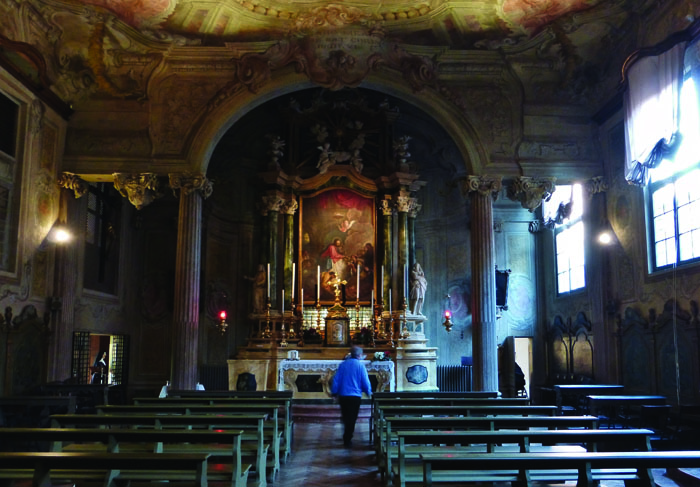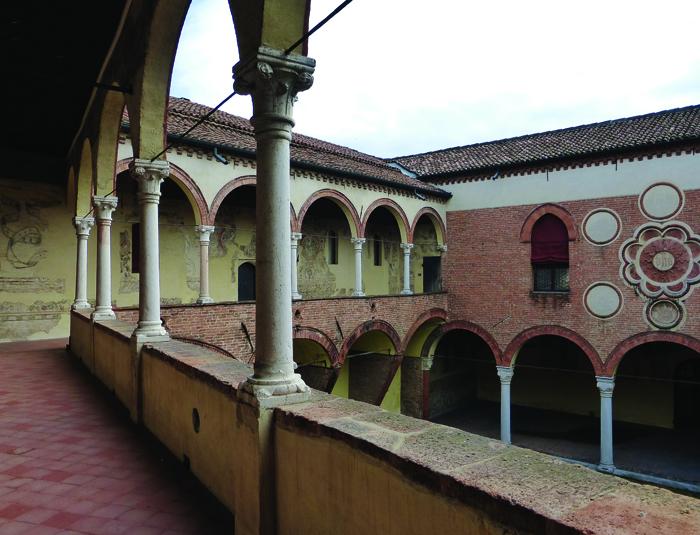Joe Gartman reveals the ghosts of the past in Ferrera, a city where long-gone rulers and clergymen left unfinished business…
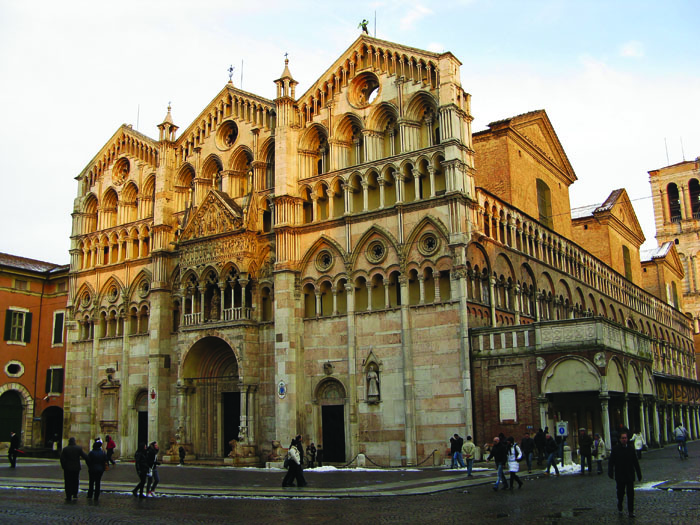
Ghosts don’t exist, I am inclined to believe, but the atmosphere of Ferrara is distinctly eerie. Maybe it’s the mist floating in from the Po Delta, to east of the city, where the great river meanders and splits and empties, multi-mouthed, into the Adriatic Sea. Maybe it’s the dark and gloomy streets of the medieval section around Via Volte, or maybe it’s the dungeons of Castello Estense, with their heavy iron doors and walls filled with despairing graffiti.
Don’t get me wrong. I like the town very much, especially when the sun shines; and in fairness I must mention the excellent example of town planning called the “Herculean addition” that added many grand palazzi in Renaissance style back in the 15th century. (The name is not in honour of the mythical strongman but the city’s ruler at the time, Ercole I d’Este. But I’m sure Ercole himself was named after the big guy with the club and lion’s pelt.)
Since there are no hills to negotiate everybody, including great-grandma, rides a bike; and for the same reason, Ferrara is a great walking city, as long as your hearing is acute enough to pick up the whisper of bike tires approaching from behind. It would be embarrassing to be flattened by a granny in a hurry. If you’re the imaginative sort, you might also hear the whisper of a disembodied voice from the past; because memories of unforgettable characters lurk, ghost-like, around every corner in Ferrara.
Our B&B on Via Scandiana, for example, is just a hundred yards or so from Palazzo Schifanoia, one of the delizie – suburban getaways – of the Este family, who ruled Ferrara from the 12th century until it was absorbed into the Papal States in 1597. It’s a good neighbourhood for memories, even if it has deteriorated a little since the days when the royals hung out down the street. We found a friendly bar at the corner, owned by a kindly lady who gave us careful directions to the nearest laundromat (way across town) and then offered to take us there in her car. The regular patrons listened in, added their recommendations, gulped their caffè quickly at the counter and then adjourned to the sidewalk outside to smoke and gossip.
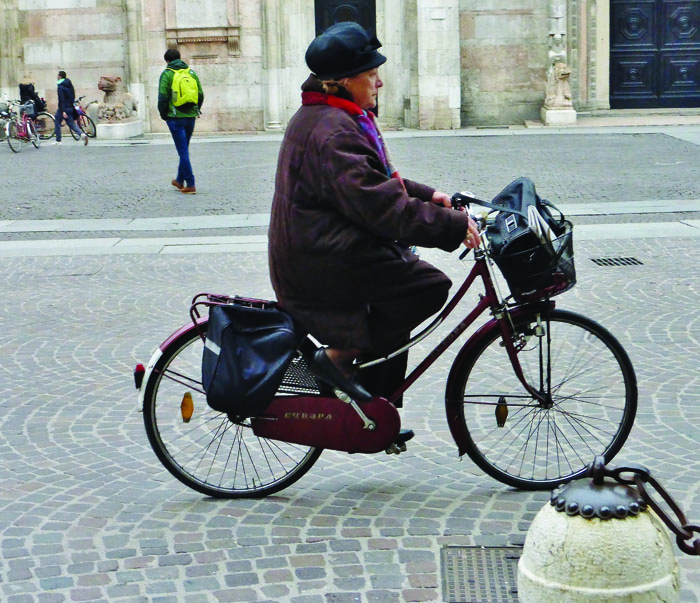
The Good Duke Borso
We decided to postpone washday and visit Schifanoia instead. The palazzo’s name derives from schivare la noia – “avoid boredom”. No doubt there was a lot of bureaucratic tedium back at the castle. In those days, around 1385, the area was green and wooded, giving the family enough privacy to throw a proper party now and then. Later, around 1470, the little getaway was expanded under Duke Borso d’Este. He wanted a suitably impressive hall upstairs where he could entertain visiting VIPs, like Pope Paul II, who crowned Borso Duke of Ferrara in 1471.
This hall is now known as the Salone dei Mesi (Hall of the Months) for the fresco cycle it contains. It’s an impressively spacious room, empty now except for a couple of benches for contemplation or massaging your feet. Once, all twelve months were represented on the four walls, but half of them are either gone completely, or too faint to enjoy. It seems that later owners of the building plastered them over! Happily, the remaining pictures are in reasonably good shape considering they’re well over 500 years old.
The decorative scheme is based on zodiacal signs and pagan figures of each month’s protective god. April, for example, honours Venus, who is shown arriving in a sumptuous river barge drawn by swans, while a large family of rabbits (of course) frisk on the bank.
Below these fanciful allegories, Borso’s artists, Cosmé Tura, Francesco del Cossa and others, have created wonderful scenes of Renaissance life in Ferrara, all depicting activities appropriate to the current month. The Ferrarese painters gloried in colour, and the lively scenes of lovers and merchants and musicians disporting themselves among detailed Renaissance architecture, and gardens filled with flowers, are still splendid; but what they must have looked like when new! The frescoes are cheerful and full of life: women gowned in gorgeous fabrics, men in their parti-coloured hose and doublets, painted with dazzling skill.
Clearly the pictures extol the benefits of good government, and to drive the message home, Borso figures in each of the scenes, looking benevolent, handing out small change, or just checking to make sure everyone’s having a good time. He is painted each time with the same expression, a kind of avuncular half-smile, looking just a little bit goofy with it. Come to think of it, his statue outside city hall is the same. It’s a look that seems to say, “Hey, don’t worry, it’s just me, kindly old Uncle Borso. Don’t believe all those rumours about dungeons in the castle. It’s only a root cellar.”
Perhaps he was telling the truth. He was known as “Good Duke Borso” after his death. Some of his artists, though, complained that he was a slow payer.
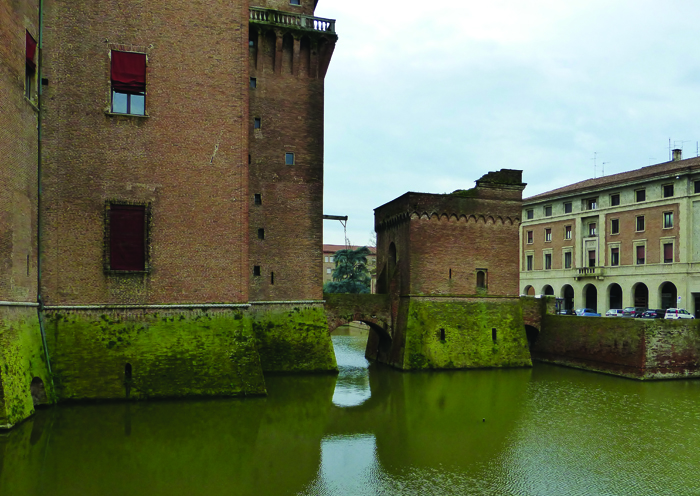
Genii Locorum – The Spirits of Places
Across the street from the bar is the church of Santa Maria in Vado, site of a miracle in March, 1171, when, during Mass, blood spurted from the host so prodigiously that it stained the vault above the altar. You can visit and perhaps see the miraculous stain, although, like many buildings in Ferrara, the church was badly damaged during the 2012 earthquakes and may be closed.
There are a couple of other aristocratic buildings in our neighbourhood, including a small palazzina that belonged to Marfisa d’Este, who inherited it from her father, Francesco d’Este. She refused to leave when the Este family fell from power, and apparently lived there untroubled until her death. It contains paintings and furniture from the 16th century, and has a pleasant garden to enjoy, complete with a frescoed loggia.
Just around the corner is a beautiful and well-preserved Renaissance palace, the Casa Romei, with elegant loggias surrounding the cortile, a frescoed “Room of the Sibyls”, and a grand terracotta fireplace. It was the home of Giovanni Romei, a local aristocrat, who willed it to the nuns of Corpus Domini. Later, Cardinal Ippolito II d’Este had it renovated so that part of it would serve as his private apartments. (If you have ever enjoyed the fountains of Villa d’Este in Tivoli, you have already visited another of Ippolito’s residences.)
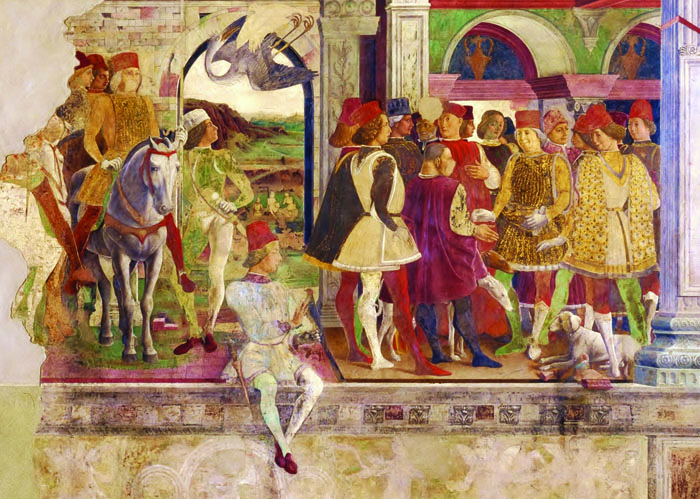
The Perils of Lucrezia
Ippolito was a son of Lucrezia Borgia, born when she was Duchess of Ferrara and wife of Alfonso I d’Este. Of all the ghosts in Ferrara, she’s the shade I’d most like to interview. Was she really a deadly femme fatale or merely the victim of her father’s unscrupulous machinations and the mudslinging of his enemies? Her father was Pope Alexander VI, Rodrigo Borgia. (Alexander had four children, including the notorious Cesare Borgia, by his mistress Vanozza dei Cattanei. The Pope acknowledged them openly. There was no fol-de-rol about “nieces and nephews” for Rodrigo.)
Lucrezia was married three times, each match arranged by her father to suit his political and familial ambitions. When the first two marriages ceased to be useful to him, they were ended by rather unusual means: the first, to Giovanni Sforza, was annulled when Giovanni “confessed”, under pressure, to impotence; the second ended when her young husband, Alfonso of Aragon, was strangled to death, probably by Lucrezia’s ruthless brother Cesare.
Lucrezia was the focus of a maelstrom of gossip and rumour: was she pregnant when her first marriage was annulled? Was there a child? Who was the father? Why did two servants from the Borgia household drown in the Tiber? Was it true that Lucrezia had improper relations with Cesare, or even Alexander himself? Did she really wear a ring full of poison, and empty it into the soup of the day when necessary?
Her third marriage, to Duke Alfonso I d’Este, took her out of the Roman spotlight and brought her to Ferrara. Here, as Duchess, she was popular and respected. Even so, there were still rumours. The Duke had a roving eye, and perhaps Lucrezia returned the favour. She and Francesco II Gonzaga, ruler of Mantua, may have had an affair. Francesco was the husband of Isabella d’Este, Alfonso’s sister. She also exchanged passionate letters with the poet and Cardinal, Pietro Bembo, and was an ardent pen-pal of the poet Ariosto. Still, she and Duke Alfonso had seven or perhaps eight children, although only four survived to adulthood. Lucrezia died from complications of childbirth at the age of 39.
Duke Alfonso was a chap who evidently liked to take chances. Besides marrying a girl who had a bad reputation in the kitchen, he also got on the wrong side of Pope Julius II by supporting France and Spain against the Papal territorial claims. Julius excommunicated him in 1509. However, Alfonso was a great patron of the arts, both literary and visual, attracting poets like Bembo and Ariosto, and commissioning paintings from Giovanni Bellini and Titian. He also outlived Julius.
Lucrezia and Alfonso’s grandson, the later Duke Alfonso II, is thought to be the subject of Robert Browning’s poem My Last Duchess, about a nobleman who murders his young wife. Alfonso II’s first wife died at 17, either from tuberculosis or, it was strongly suspected at the time, poison.
There are, of course, several places in Ferrara where you might hope to encounter the spectres of both Lucrezia and Alfonso. One is the Castello Estense, still sitting massively in its moat, in the centre of town. It’s been there since 1385, and seems impregnable. But it, too, was damaged in the earthquakes of 2012. Nowadays its perimeter is guarded, not by the Duke’s soldiers, but by a fellow in a rowboat who patrols the moat picking up floating candy wrappers. The dungeons are still there, however. You can visit them if you like. Don’t let that door slam shut behind you!
The cells were sometimes occupied by family – Duke Alfonso shut two of his brothers, Ferrante and Giulio, in the castle’s tower, Torre dei Leoni, for plotting against him. Ferrante died in his cell after 34 years, but Giulio was released by a later Duke after 53 years in the tower.
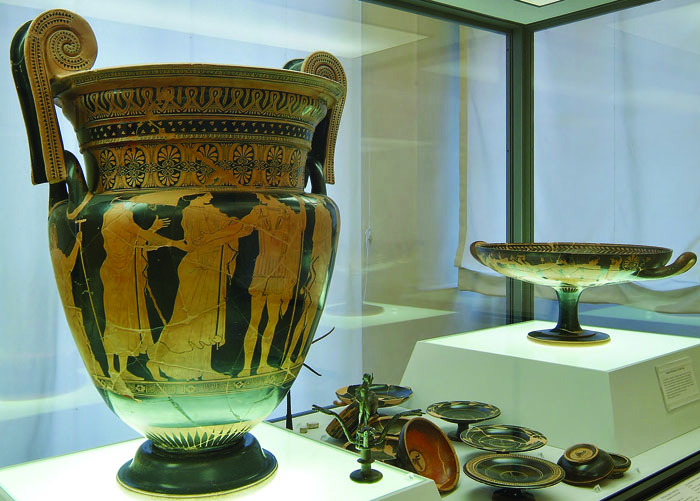
Vows of Silence
A few minutes’ walk from our B&B, in Via Pergolata, we found another reminder of the Duke and Duchess – the Church and Convent of Corpus Domini, home to a community of the Poor Clares. Several members of the Este family are buried there. We wanted to see Lucrezia’s tomb, and rang a bell at the Convent entrance door. An actual disembodied voice – this one issued from an intercom box – directed us to the church door. In the dimly lit Baroque interior, we spotted a figure in brown and white behind a grille in the left aisle, near the apse.
She greeted us charmingly, smiled knowingly when we mentioned Lucrezia’s tomb, and sent for help. Help arrived – a small and energetic fellow who pretended we had come to learn the life story of St Catherine de’Vigri, the founder of the monastery. She was a mystic, a writer, and an expert baker – her ancient ovens still operate in the convent. She lived her later years in Bologna, where her incorrupt remains, dressed in her habit and seated on a throne, can be seen in Bologna’s Corpus Domini Church. I must remember to visit when I next go to Bologna.
At last, and with a twinkle in his eye, our host showed us six marble slabs, with worn inscriptions, in the nun’s choir. “Lvcretie Borgie” is carved on one, along with the Duke’s name and those of two of their children. I listened for a voice, but Lucrezia wasn’t talking.
The Scourge of Wickedness
Girolamo Savonarola was born in Ferrara in 1452, and is a bit of a favourite son despite some bother he got into in Florence. He denounced the sins of Pope Alexander, the Medici, and just about everybody else; he gained control of Florence, lit bonfires fuelled with books and paintings, and finally was hanged and burned in Piazza Signoria.
A statue of the fiery (in more ways than one) preacher, showing him in full oratorical flight, stands near the castle in – appropriately – Piazza Savonarola. It was erected in 1875. An inscription on the plinth says, “To Girolamo Savonarola, in corrupt and servile times of vice and tyranny, the scourge!”
As Savonarola himself would probably declare, if he was still sermonizing: Sic transit gloria mundi – Thus passes worldly the glory.
But not all the glory of the world has faded, certainly not in Ferrara. Out in the Herculean Addition, the Palazzo dei Diamanti still sparkles in the sun. The building is named for the diamond-shaped stones that make up the façades – three-dimensional diamond shapes, I mean. Their points protrude, and it almost seems that the Renaissance architect, Biagio Rossetti, invented the world’s first climbing wall. I suggest going inside instead. You’ll find Ferrara’s National Picture Gallery, with paintings by artists of the Ferrarese School, such as Cosmé Tura and Ercole dei Roberti.
And of course, the Cathedral of Ferrara dominates the main square, with its splendid Romanesque and Gothic marble façade. The interior is mostly Baroque restoration. In Piazza Trento e Trieste, small shops cuddle up to the great church’s flanks. Nearby, the excellent Cathedral Museum holds a rare treasure, the exquisite white marble sculpture of the Madonna della Melagrana (Madonna of the Pomegranate) by Jacopo della Quercia from 1408, an unforgettable masterpiece.
Ferrara has much more to see and do – six miles of 15th-century walls can be hiked or biked; there’s a fine archaeological museum housed in a palace built by Ludovico il Moro’s ambassador, Antonio Costabili; poetry lovers can visit Ludovico Ariosto’s house, where he worked on Orlando Furioso, and possibly dreamed of Lucrezia; the atmospheric old Jewish quarter can be explored around Via Mazzini; and Via Volte will lead you into the middle ages.
The city is atmospheric, beautiful in its own way, wildly historic, and, as I said, a bit eerie. It certainly deserves a visit of several days, at least – which means you’ll probably need to wash your clothes. My advice is to shove your undies in a pillowcase, borrow a bicycle, and ride like a native to the laundromat.
